Physical Address
304 North Cardinal St.
Dorchester Center, MA 02124
An understanding of venous physiology provides the surgeon with valuable information with which to formulate a diagnostic and treatment plan. Technologic advances have broadened the therapeutic armamentarium. This chapter provides the reader with a thorough overview of the physiology and pathophysiology of the venous system. Pathognomonic features of superficial and deep venous disorders are described with discussion of appropriate diagnostic modalities and therapeutic interventions.
TriVex 1
TriVex 2
To determine whether a pathophysiologic process is present, knowledge of venous anatomy is essential. Venous drainage of the legs is the function of two parallel systems: the superficial and the deep venous system, in anatomic continuity through connecting veins, called perforating veins. The nomenclature of the venous system of the lower limb was revised in 2002, and the most relevant changes are addressed here. The revised nomenclature is delineated in Tables 65.1 and 65.2 .
| Anatomic Terminology | New Terminology |
|---|---|
| Greater or long saphenous vein | Great saphenous veinSuperficial inguinal veins |
| External pudendal vein | External pudendal vein |
| Superficial circumflex vein | Superficial circumflex iliac vein |
| Superficial epigastric vein | Superficial epigastric vein |
| Superficial dorsal vein of clitoris or penis | Superficial dorsal vein of clitoris or penis |
| Anterior labial veins | Anterior labial veins |
| Anterior scrotal veins | Anterior scrotal veins |
| Accessory saphenous vein | Anterior accessory great saphenous vein |
| Posterior accessory great saphenous vein | |
| Superficial accessory great saphenous vein | |
| Smaller or short saphenous vein | Small saphenous veinCranial extension of small saphenous vein |
| Superficial accessory small saphenous vein | |
| Anterior thigh circumflex vein | |
| Posterior thigh circumflex vein | |
| Intersaphenous veins | |
| Lateral venous system | |
| Dorsal venous network of the foot | Dorsal venous network of the foot |
| Dorsal venous arch of the foot | Dorsal venous arch of the foot |
| Dorsal metatarsal veins | Superficial metatarsal veins (dorsal and plantar) |
| Plantar venous network | Plantar venous subcutaneous network |
| Plantar venous arch | |
| Plantar metatarsal veins | Superficial digital veins (dorsal and plantar) |
| Lateral marginal vein | Lateral marginal vein |
| Medial marginal vein | Medial marginal vein |
| Anatomic Terminology | New Terminology |
|---|---|
| Femoral vein | Common femoral vein |
| Femoral vein | |
| Profunda femoris vein or deep vein of thigh | Profunda femoris vein or deep femoral vein |
| Medial circumflex femoral vein | Medial circumflex femoral vein |
| Lateral circumflex femoral vein | Lateral circumflex femoral vein |
| Perforating veins | Deep femoral communicating veins (accompanying veins of perforating arteries) |
| Sciatic vein | |
| Popliteal vein | Popliteal vein |
| Sural veins | |
| Soleal veins | |
| Gastrocnemius veins | |
| Medial gastrocnemius veins | |
| Lateral gastrocnemius veins | |
| Intergemellar vein | |
| Genicular veins | Genicular venous plexus |
| Anterior tibial veins | Anterior tibial veins |
| Posterior tibial veins | Posterior tibial veins |
| Fibular or peroneal veins | Fibular or peroneal veins |
| Medial plantar veins | |
| Lateral plantar veins | |
| Deep plantar venous arch | |
| Deep metatarsal veins (plantar and dorsal) | |
| Deep digital veins (plantar and dorsal) | |
| Pedal vein |
The superficial veins of the lower extremity form a network that connects the superficial dorsal veins of the foot and deep plantar veins. The dorsal venous arch, into which empty the dorsal metatarsal veins, is continuous with the great saphenous vein medially and the small saphenous vein laterally ( Fig. 65.1 ).
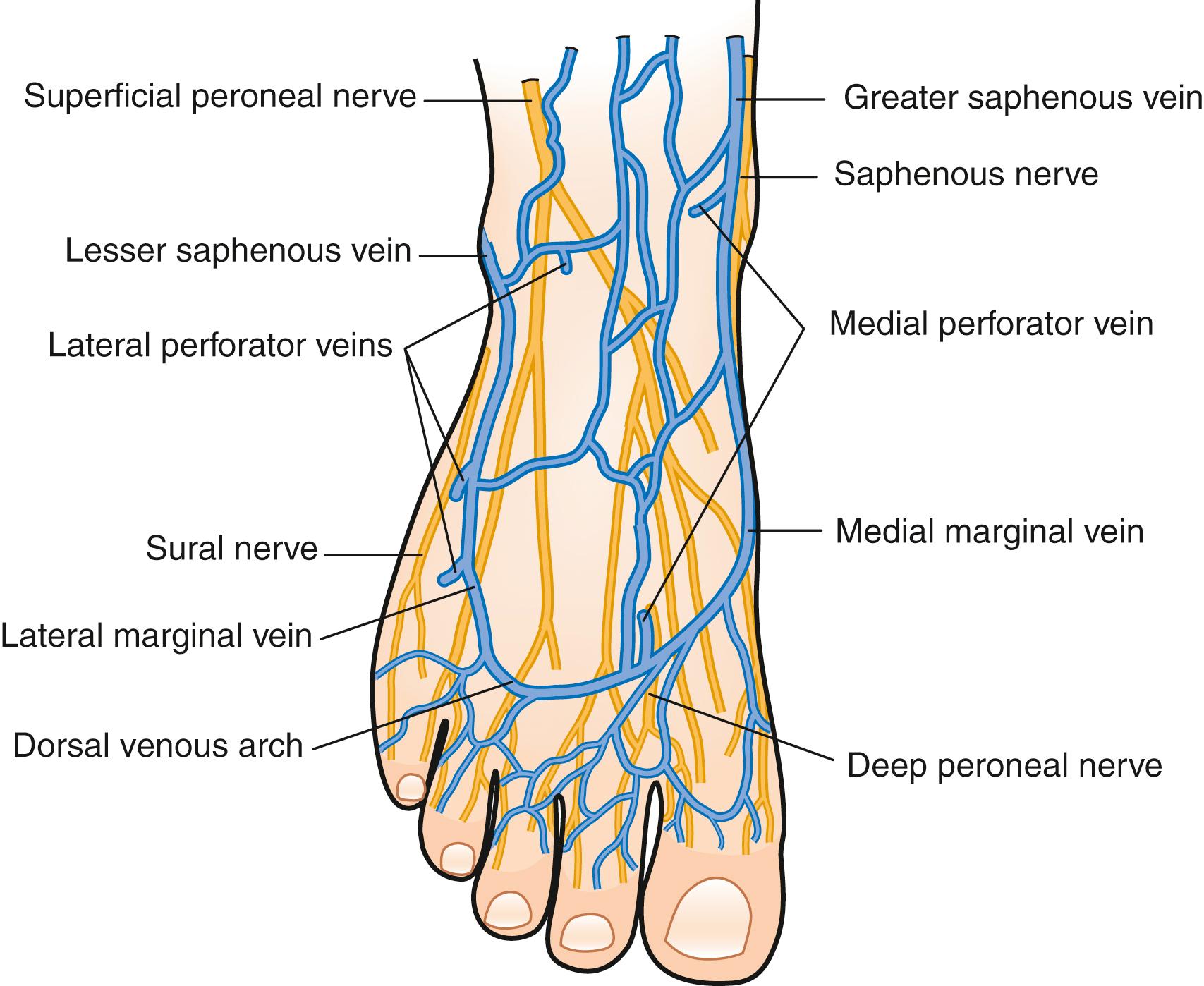
The great saphenous vein arises from dorsal veins of the foot. The great saphenous vein extends cephalad and travels over the medial aspect of the tibia and in parallel to the saphenous nerve. As the great saphenous vein ascends through the thigh, multiple accessory branches are demonstrated, and variability of the number and location of these branches is the norm. The great saphenous vein travels within its own fascia, called the saphenous sheath ( Fig. 65.2 ). This structure is superior to the deep fascia of the leg. Although a classic feature, the great saphenous vein can be contained completely within the saphenous sheath or exit the fascia and reenter at another point in its course along the extremity. In some cases, patients exhibit an incomplete saphenous sheath, which makes identification of the great saphenous vein difficult. The great saphenous vein terminates into the saphenofemoral junction, where it is joined by the confluence of the superficial circumflex iliac veins, the external pudendal veins, and the superficial epigastric veins. It then ascends in the superficial compartment and empties into the common femoral vein after entering the fossa ovalis ( Fig. 65.2 ). The saphenofemoral junction is a complex anatomic entity composed of one or several external pudendal veins, the superficial epigastric vein, the superficial circumflex vein, and one or several accessory saphenous veins, whose course in the leg can be anterior and posterior to the great saphenous vein. At the saphenofemoral junction and a few millimeters distal in thigh, the terminal valve and the preterminal, are located.
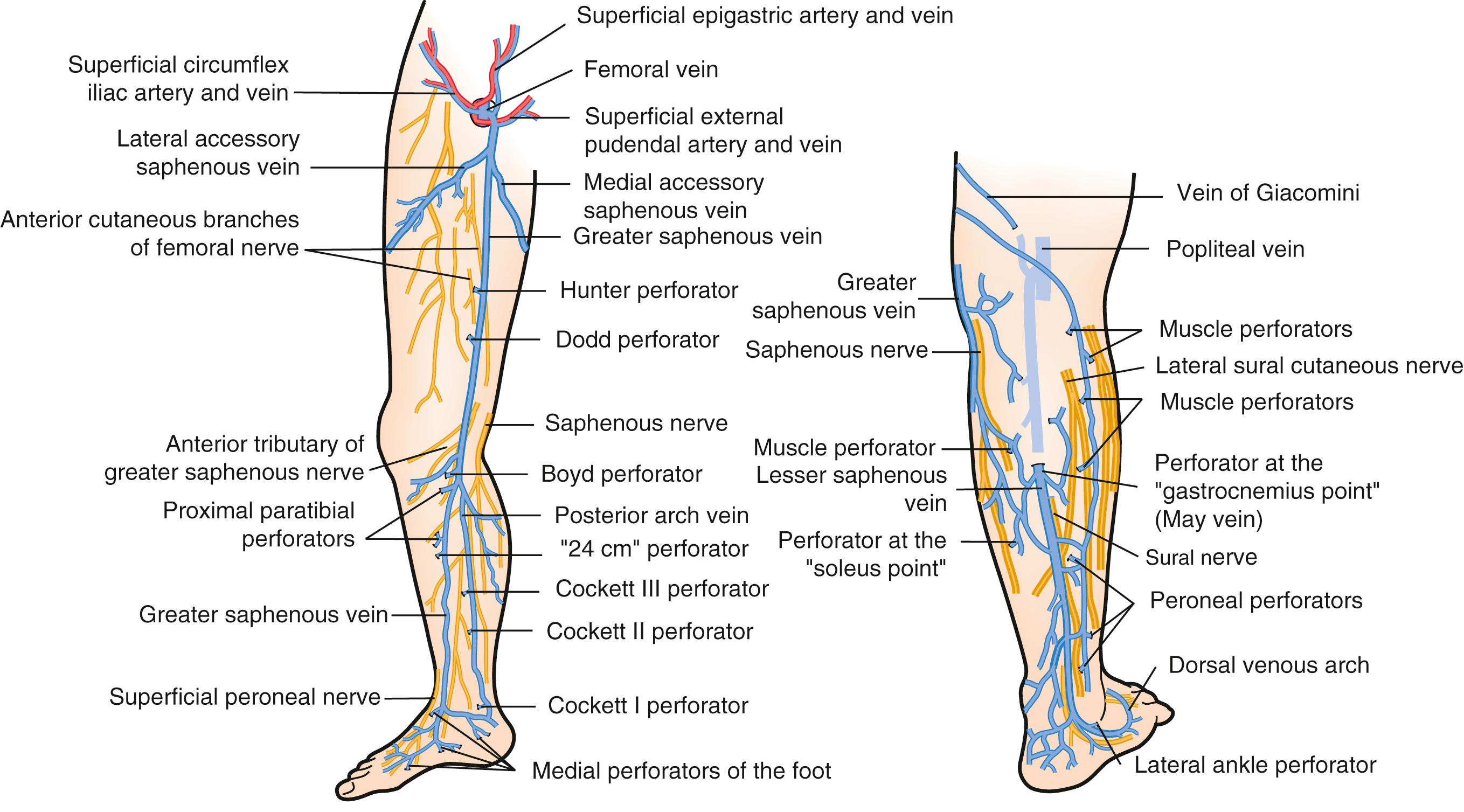
The small saphenous vein arises from the dorsal venous arch at the lateral aspect of the foot and ascends posterior to the lateral malleolus, rising cephalad in the midposterior calf. The small saphenous vein continues to ascend, penetrates the superficial fascia of the calf, and then terminates into the popliteal vein. However, this anatomy is extremely variable. Most commonly, the small saphenous vein terminates within a lateral branch of the thigh, bypassing the classic saphenopopliteal junction. The sural nerve lies parallel to the small saphenous vein. This relationship becomes more intimate at the distal calf. A common vein branch, the vein of Giacomini, connects the small saphenous vein with the great saphenous vein.
The plantar digital veins in the foot empty into a network of metatarsal veins that compose the deep plantar venous arch. This continues into the medial and lateral plantar veins, which then drain into the posterior tibial veins. The dorsalis pedis veins on the dorsum of the foot form the paired anterior tibial veins at the ankle.
The paired posterior tibial veins, adjacent to and flanking the posterior tibial artery, run under the fascia of the deep posterior compartment. These veins enter the soleus and join the popliteal vein, after joining with the paired peroneal and anterior tibial veins. There are large venous sinuses within the soleus muscle—soleal sinuses—that empty into the posterior tibial and peroneal veins. Bilateral gastrocnemius veins empty into the popliteal vein distal to the point of entry of the small saphenous vein into the popliteal vein.
The popliteal vein enters a window in the adductor magnus, at which point it is termed the femoral vein, previously known as the superficial femoral vein. The femoral vein ascends and receives venous drainage from the profunda femoris vein, or deep femoral vein, and after this confluence, it is the common femoral vein. As the common femoral vein crosses the inguinal ligament, it becomes the external iliac vein.
Perforating veins connect the superficial venous system to the deep venous system by penetrating the fascial layers of the lower extremity. These perforators run in a perpendicular fashion to the axial veins previously described. Although the total number of perforator veins is variable, up to 100 have been documented. The perforators enter at various points in the leg—the foot, medial and lateral calf, and mid and distal thigh ( Fig. 65.3 ). Some have been named by the surgeons who first identified them: Crockett perforators, which connect the posterior arch and posterior tibial veins; Boyd perforators, which connect the great saphenous and gastrocnemius veins; and hunterian and Dodd perforators, which connect the great saphenous and superficial femoral veins. The perforator veins have an important function. Their valve system aids in preventing reflux from the deep to the superficial system, particularly during periods of standing and ambulation. Perforating veins are currently identified by measuring their distance from the heel.
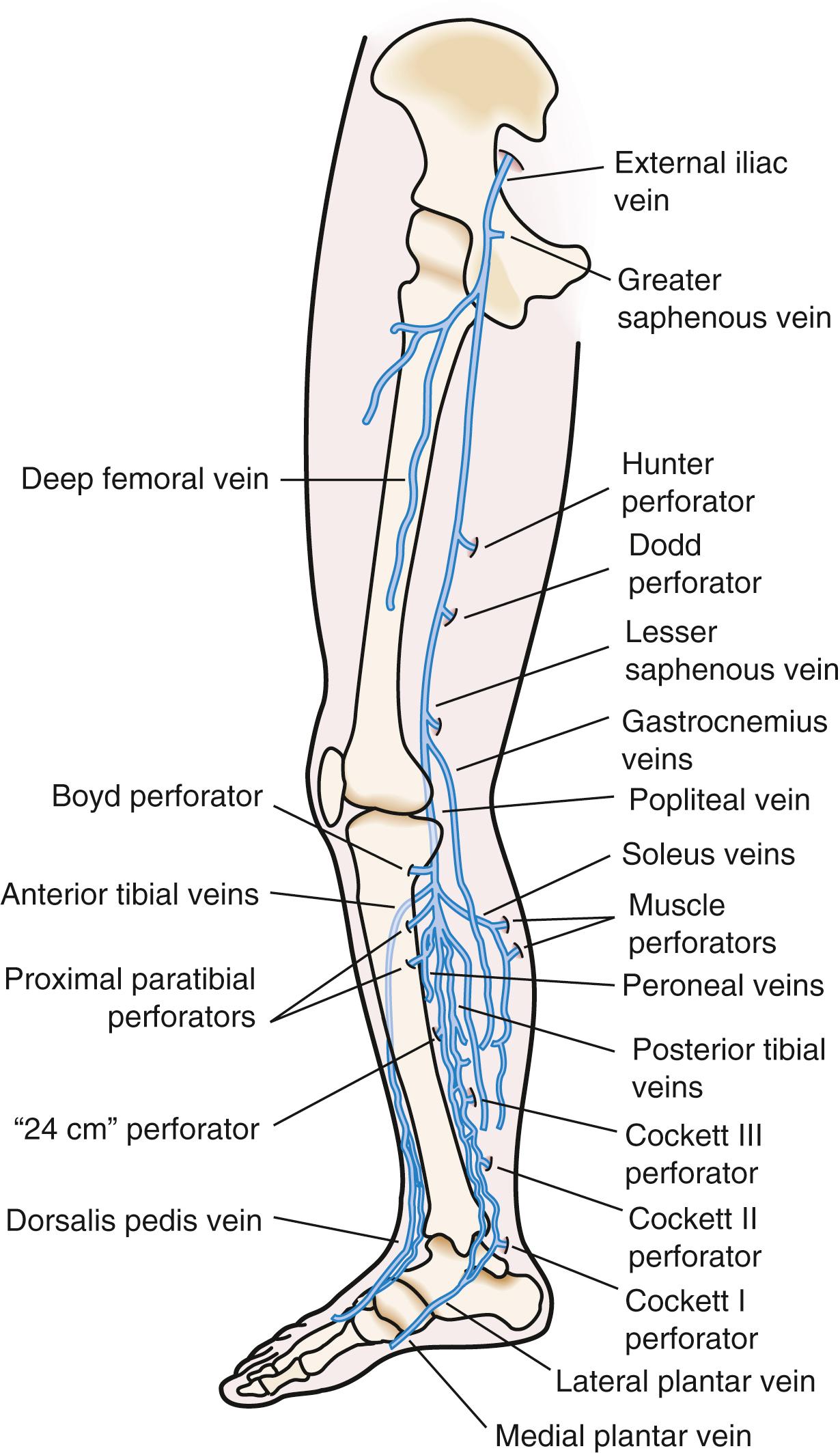
The venous wall is composed of three layers, the intima, media, and adventitia. Vein walls have less smooth muscle and elastin than their arterial counterparts. The venous intima has an endothelial cell layer resting on a basement membrane. The intima enfolds forming bicuspid valves whose function is to assure venous return to the heart. The media is composed of smooth muscle cells and elastin connective tissue. The adventitia of the venous wall contains adrenergic fibers, particularly in the cutaneous veins. Central sympathetic discharge and brainstem thermoregulatory centers can alter venous tone, as can other stimuli, such as temperature changes, pain, emotional stimuli, and volume changes.
The histologic features of veins vary, depending on the caliber of the veins. The venules, the smallest veins, range from 0.1 to 1 mm and contain mostly smooth muscle cells, whereas the larger extremity veins contain relatively few smooth muscle cells. These larger caliber veins have limited contractile capacity in comparison to the thicker walled great saphenous vein. The venous valves prevent retrograde flow; it is their failure or valvular incompetence that leads to reflux and its associated symptoms. Venous valves are most prevalent in the distal lower extremity, whereas as one proceeds proximally, the number of valves decreases to the point that no valves are present in the superior vena cava and inferior vena cava (IVC).
Most of the capacitance of the vascular tree is in the venous system. Because veins do not have significant amounts of elastin, veins can withstand large volume shifts with comparatively small changes in pressure. A vein has a normal elliptical configuration until the limit of its capacitance is reached, at which point the vein assumes a round configuration.
The calf muscles augment venous return by functioning as a pump. In the supine state, the resting venous pressure in the foot is the sum of the residual kinetic energy minus the resistance in the arterioles and precapillary sphincters. Thus, a pressure gradient is generated to the right atrium of approximately 10 to 12 mm Hg. In the upright position, the resting venous pressure of the foot reflects the hydrostatic pressure from the upright column of blood extending from the right atrium to the foot.
The return of the blood to the heart from the lower extremity is facilitated by the muscle pump function of the calf, a mechanism whereby the calf muscle, functioning as a bellows during exercise, compresses the gastrocnemius and soleal sinuses and propels the blood toward the heart. The normally functioning valves in the venous system prevent retrograde flow; when one or more of these valves become incompetent, symptoms of venous insufficiency can develop. During calf muscle contraction, the venous pressure of the foot and ankle drops dramatically. The pressures developing in the muscle compartments during exercise range from 150 to 200 mm Hg, and when there is failure of perforating veins, these high pressures are transmitted to the superficial system.
Chronic venous insufficiency (CVI) is dominated by venous reflux through incompetent venous valves.
There are three categories of venous insufficiency—congenital, primary, and secondary. Congenital venous insufficiency comprises predominantly anatomic variants that are present at birth. Examples of congenital venous anomalies include venous ectasias, absence of venous valves, and syndromes such as Klippel-Trénaunay syndrome. While the secondary venous insufficiency can be considered a sequela of a previous acute thrombotic disorder (postthrombotic syndrome [PTS]), the etiology of primary CVI cannot be clearly identified.
Risk factors for the development of varicose veins include advancing age, female gender, multiparity, heredity, history of trauma to the extremity, and prolonged standing. Additional risk factors include obesity and a positive family history. Advancing age appears to be an important significant risk factor. Venous function is undoubtedly influenced by hormonal changes. In particular, progesterone liberated by the corpus luteum stabilizes the uterus by causing the relaxation of smooth muscle fibers. This directly influences venous function. The result is passive venous dilation, which in many cases causes valvular dysfunction. Although progesterone is implicated in the first appearance of varicosities in pregnancy, estrogen also has profound effects. It produces the relaxation of smooth muscle and a softening of collagen fibers. Furthermore, the estrogen-to-progesterone ratio influences venous distensibility. This ratio may explain the predominance of venous insufficiency symptoms on the first day of a menstrual period, when a profound shift occurs from the progesterone phase of the menstrual cycle to the estrogen phase. Autosomal dominant penetrance has been identified as the underlying genetic risk factor for subsequent development of varicose veins.
Venous reflux through incompetent venous valves has been described as the main pathogenetic factor underlying CVI. However, obstruction of venous channels, due to either intrinsic narrowing, postthrombotic thickening and scarring, or external compression, may also result in venous hypertension leading to CVI. In many cases, particularly after venous thrombosis, obstruction, and reflux coexist resulting in severe CVI.
Anatomic differences in the location of the superficial veins of the lower extremities may contribute to the pathogenesis. Primary venous insufficiency may involve both the axial veins (great and small saphenous), either vein, or neither vein. Perforating veins may be the sole source of venous pathophysiologic changes, perhaps because the great saphenous vein is supported by a well-developed medial fibromuscular layer and fibrous connective tissue that bind it to the deep fascia. In contrast, tributaries to the small saphenous vein are less supported in the subcutaneous fat and are superficial to the membranous layer of superficial fascia ( Fig. 65.4 ). These tributaries also contain less muscle mass in their walls. Thus, these veins, and not the main trunk, may become selectively varicose.
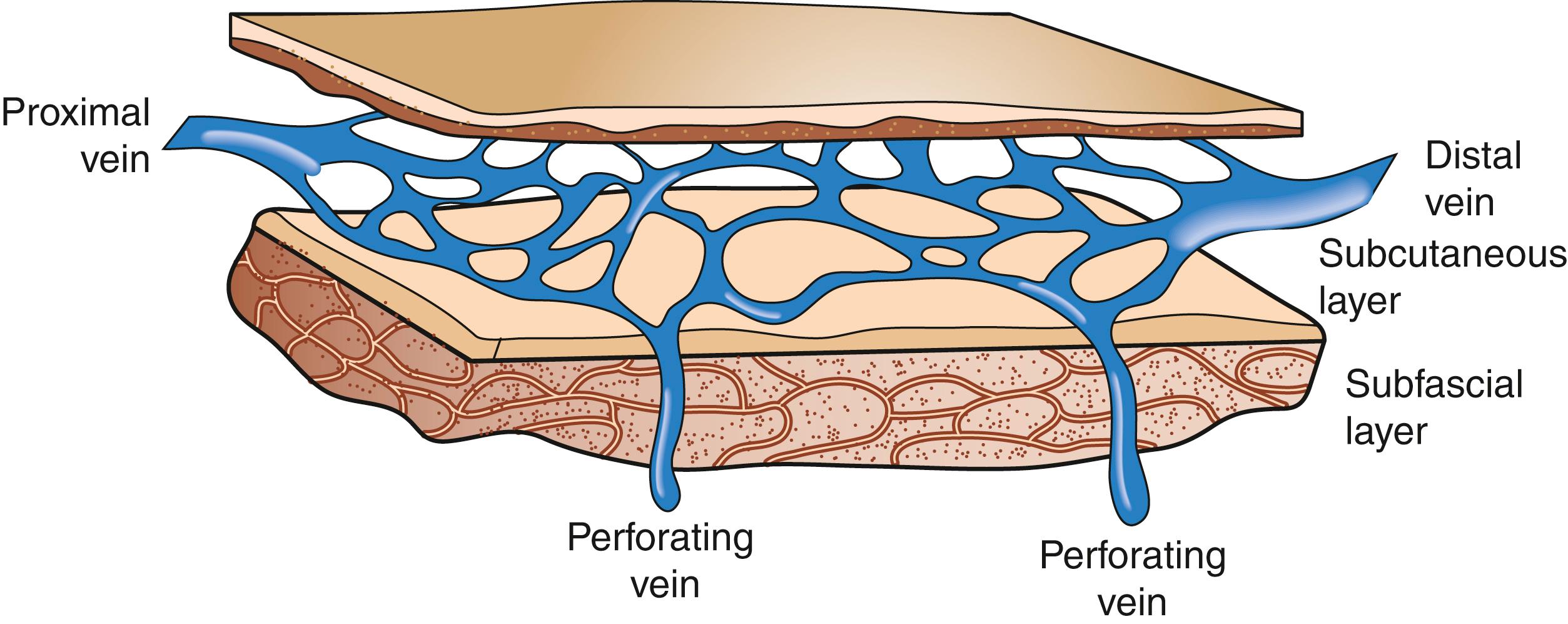
When these fundamental anatomic peculiarities are recognized, the intrinsic competence or incompetence of the valve system becomes important. For example, failure of a valve protecting a tributary vein from the pressures of the small saphenous vein allows a cluster of varicosities to develop. Furthermore, communicating veins connecting the deep with the superficial compartment may have valve failure. Pressure studies have shown that there are two sources of venous hypertension. The first is gravitational and is a result of venous blood coursing in a distal direction down linear axial venous segments. This is referred to as hydrostatic pressure and is the weight of the blood column from the right atrium. The highest pressure generated by this mechanism is evident at the ankle and foot, where measurements are expressed in centimeters of water or millimeters of mercury.
The second source of venous hypertension is dynamic. It is the force of muscle contraction, usually contained within the compartments of the leg. If a perforating vein fails, high pressures (range, 150–200 mm Hg) developed within the muscular compartments during exercise are transmitted directly to the superficial venous system. Here, the sudden pressure transmitted causes dilation and lengthening of the superficial veins. Progressive distal valvular incompetence may occur. If proximal valves such as the saphenofemoral valve become incompetent, systolic muscular contraction is supplemented by the weight of the static column of blood from the heart. Furthermore, this static column becomes a barrier. Blood flowing proximally through the femoral vein spills into the saphenous vein and flows distally. As it refluxes distally through progressively incompetent valves, it is returned through perforating veins to the deep veins. Here, it is conveyed once again to the femoral veins, only to be recycled distally.
Regardless of the precise source of the elevated hydrostatic pressure, the ultimate end result is increased ambulatory venous hypertension.
A number of authors have demonstrated that the development of all the clinical manifestations of CVI can be ascribed to a blood flow driven inflammatory process. Leukocytes are activated and marginalize. Adhesion to the endothelium is prompted by the expression of adhesion molecules, such as Intracellular Adhesion Molecule 1 (ICAM-1), Vascular Cell Adhesion Molecule 1(VCAM-1), L and P-selectins. Ultimately, they infiltrate the venous wall, lyse, and release activated extracellular matrix enzymes (Matrix Metallopeptidase 1, 2, and 9 [MMP1, MMP2, and MMP9]). The extracellular matrix is degraded and the venous wall, including the valves, undergoes remodeling. Decreased amounts of elastin and an imbalance between collagen I and III have been identified in surgical specimens, suggesting that the loss of the venous wall intimal architecture leads to dilation, tortuosity, and the formation of varicose veins. ,
The patient with symptomatic varicose veins commonly reports heaviness, discomfort, and extremity fatigue. The pain is characteristically dull, does not usually occur during recumbency or early in the morning, and is exacerbated in the afternoon, especially after periods of prolonged standing. Swelling is commonly described. The discomforts of aching, heaviness, and fatigue are usually relieved by leg elevation or elastic support. Cutaneous burning, termed venous neuropathy, can also occur in patients with advanced venous insufficiency. Pruritus occurs from excess hemosiderin deposition and tends to be located at the distal calf or in areas of phlebitic varicose branch segments. Patients may report cramping pain that occurs during or after exercise and is relieved with rest and leg elevation. This syndrome is termed venous claudication and is a clinical manifestation of venous outflow obstruction, secondary venous insufficiency. Predominant causes of venous claudication include a prior deep venous thrombosis (DVT) and May-Thurner syndrome.
Multiparous female patients in their childbearing years may report a constellation of symptoms that involve varicosities of the leg in conjunction with chronic pelvic pain. The lower extremity symptoms may or may not be present. Additional symptoms include a feeling of bladder fullness with standing, dyspareunia, and chronic pelvic pain. This clinical picture suggests pelvic congestion syndrome. As the differential diagnosis for pelvic pain is extensive, the diagnosis of pelvic venous congestion tends to be one of exclusion; diagnostic modalities to confirm its presence include magnetic resonance venous imaging (MRVI) of the pelvis and conventional pelvic venography, which can be both diagnostic and therapeutic.
A comprehensive examination includes assessment of the arterial circulation. Briefly, palpation of the femoral, popliteal, dorsalis pedis, and posterior tibialis pulses is performed. Nonpalpable pulses necessitate further evaluation. Auscultation of pulse flow is indicated when a thrill or widened pulse is appreciated. Decreased hair, dependent rubor, pallor on elevation, and tissue loss are all indicative of advanced arterial ischemia.
The venous examination includes assessment of the patient in the standing and supine positions. The examination room must be well lighted and warm so that vasospasm does not occur, limiting a comprehensive evaluation. Standing increases venous hypertension and dilates veins, thereby facilitating examination. Patients with superficial axial incompetence commonly exhibit palpable great saphenous veins ( Fig. 65.5 ).
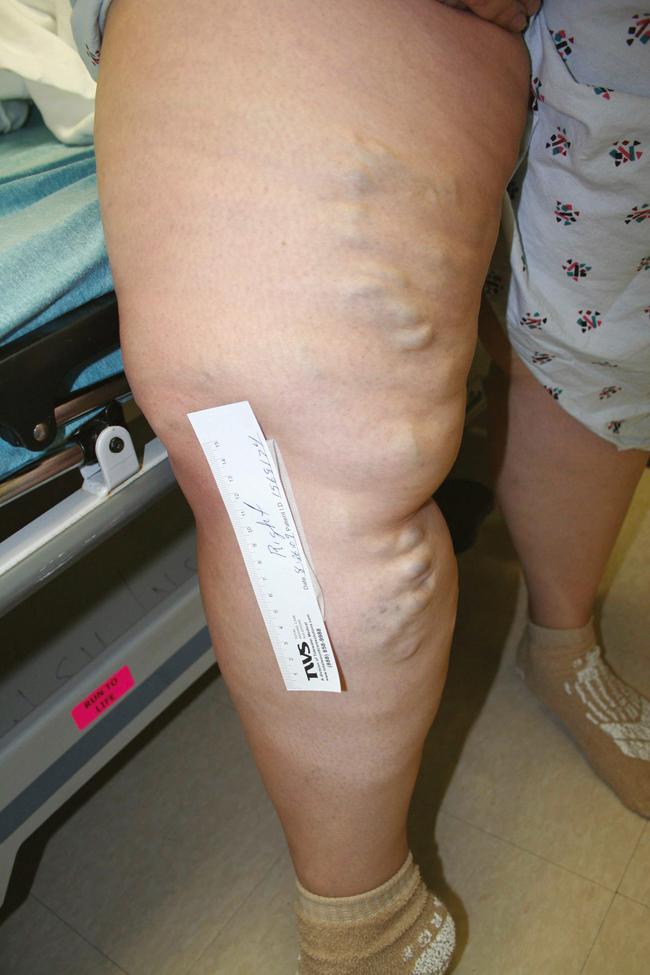
Visual inspection is critical. There are three main anatomic categories of primary venous insufficiency—telangiectasias, reticular veins, and varicose veins. Telangiectasias, reticular varicosities, and varicose veins are similar but exhibit distinct variations in caliber. Telangiectasias are very small intradermal venules. These structures measure less than 3 mm. Without associated symptoms and stigmata of other venous disease, they are idiopathic in nature and are not medically necessary to treat.
Leg telangiectasias of multiple causes may be a manifestation of a systemic disease. Some of these disorders include autoimmune diseases (such as lupus erythematosus and dermatomyositis), exogenous causes, and xeroderma pigmentosum. Reticular veins are vein branches that enter the tributaries of the main axial, perforating, or deep veins. The axial veins, the great and small saphenous veins, represent the largest caliber veins of the superficial venous system.
Location of varicosities can commonly identify an incompetent valve or the axial vein from which the varicosities developed. For example, medial thigh varicose veins are likely to develop from an incompetent great saphenous vein, whereas posterior calf or lateral calf varicose veins tend to originate from the small saphenous vein. In addition, the location of varicose veins can be a diagnostic predictor of a larger process. Varicosities of the scrotum can be associated with gonadal vein incompetence, otherwise termed the nutcracker syndrome (compression of the left renal vein between the aorta and the superior mesenteric artery). Perineal or vulvar varicosities can be a sign of ovarian or pelvic venous insufficiency, or iliac vein obstruction.
The physical examination can provide the physician with important information on the history of the venous disease that the patient might have neglected or forgotten to mention during the history. For example, signs of a chronic or resolved thrombophlebitis may include a partially thrombosed varicosity; a brownish discoloration around a varicosity or along a palpable segment of the axial veins, consistent with hemosiderin deposition; and palpable segments of axial vein, suggesting partially or completely occluded axial vein segments.
Signs of advanced venous insufficiency include hyperpigmentation in the distal calf or gaiter distribution, secondary to hemosiderin deposition, and lipodermatosclerosis. Lipodermatosclerosis develops over time because of prolonged ambulatory venous hypertension and chronic inflammation. Physical examination findings that reflect lipodermatosclerosis are brawny edema of the distal calf, “champagne bottle leg,” fibrotic and hypertrophic skin, and hyperpigmentation. Advanced lipodermatosclerosis may involve fibrosis of the Achilles tendon, impairing motor function of the extremity. Therefore, examination should include motor function at the ankle. Atrophie blanche is an area of pale hue, visualized around the medial malleolus; it is commonly mistaken for a healed ulcer because of its lighter pigmentation ( Fig. 65.6 ). Corona phlebectatica is a term used to describe an accumulation of tiny telangiectasias or venous flare, usually located at the medial malleolus or the dorsum of the foot. Skin changes from CVI can mimic other dermatologic phenomena; both dermatitis and eczematous changes can be seen from venous disease.
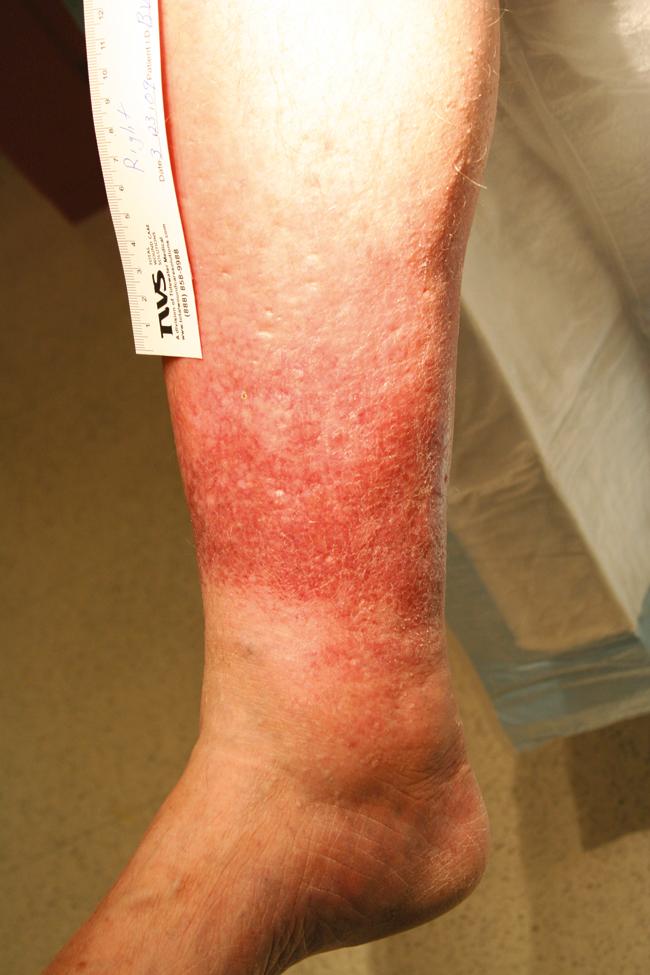
Venous stasis ulcers exhibit pathognomonic features that distinguish them from their arterial or neuropathic counterparts. Venous ulcers are not generally painful and appear at the medial malleolus, not in the mid to distal foot. Lack of arterial pulses in patients with a venous ulcer is unusual.
Venous stasis dermatitis is visualized at the distal ankle and can mimic eczema or dermatitis of another cause. It is this important attention to supporting features of the physical examination and history as well as confirmation with duplex reflux examination that will distinguish advanced venous stasis disease from dermatologic conditions.
The Perthes test for deep venous occlusion and the Brodie-Trendelenburg test of axial reflux have been replaced by in-office use of the continuous-wave, hand-held Doppler instrument supplemented by duplex ultrasound evaluation. The hand-held Doppler instrument can confirm an impression of saphenous reflux, which in turn dictates the operative procedure to be performed in a given patient. A common misconception is the belief that the Doppler instrument is used to locate perforating veins. Instead, it is used in specific locations to determine incompetent valves, for example, the hand-held, continuous-wave, 8-MHz flow detector placed over the great and small saphenous veins near their terminations. With distal augmentation of flow and release, normal deep breathing, and performance of a Valsalva maneuver, valve reflux is accurately identified. Formerly, the Doppler examination was supplemented by other objective studies, including photoplethysmography, mercury strain-gauge plethysmography, and photorheography. These are no longer in common use.
Another instrument reintroduced to assess physiologic function of the muscle pump and venous valves is air displacement plethysmography. Its use was discontinued after the 1960s because of its cumbersome nature. Computer technology has now allowed its reintroduction, as championed by Christopoulos and colleagues. It consists of an air chamber that surrounds the leg from knee to ankle. During calibration, leg veins are emptied by leg elevation, and the patient is then asked to stand so that leg venous volume can be quantitated and the time for filling recorded. The filling rate is then expressed in milliliters per second, thus giving readings similar to those obtained with the mercury strain-gauge technique.
Today, duplex imaging is the first and best modality to assess for the normal function and presence of venous insufficiency of the lower extremities. Duplex technology more precisely defines which veins are refluxing by imaging the superficial and deep veins. The duplex examination is commonly done with the patient supine, but this yields an erroneous evaluation of reflux. In the supine position, even when no flow is present, the valves remain open. Valve closure requires a reversal of flow with a pressure gradient that is higher proximally than distally. Thus, the duplex examination needs to be done with the patient standing or in the markedly trunk-elevated position.
There are many advantages of ultrasound imaging. The ultrasound examination is noninvasive, requires no contrast material, and can be performed in the office as well as in the hospital. Drawbacks to the modality include interobserver variability and limitations in imaging in patients with an elevated body mass index and extensive dressings. Imaging is obtained with a 7.5- or 10-MHz probe; the pulsed Doppler consists of a 3.0-MHz probe. The examination begins with the probe placed longitudinally on the groin. First, all of the deep veins are examined. Next, the superficial veins are evaluated. There are four basic components of the examination that should be included to complete a comprehensive venous evaluation of the lower extremity veins: compressibility, venous flow, augmentation after reflux, and visibility. Reflux can be demonstrated with the patient performing a Valsalva maneuver or by manual compression and release of the extremity distal to the point of the examination. A Valsalva maneuver is performed for the proximal extremity, that is, the thigh and groin, whereas compression is used for the calf. Reflux times of 500 milliseconds or longer are considered significant. Perforator veins can be visualized well with the duplex examination. Significant perforator reflux is defined as a diameter of more than 3.5 mm and a reflux time of 500 milliseconds or longer. Demonstration on duplex images of to-and-fro flow, with the presence of dilated segments, constitutes findings compatible with a refluxing perforator. In addition, Doppler studies can provide the clinician with information about the deep system. Widespread use of duplex scanning has allowed a comparison of findings between standard clinical examinations and duplex Doppler studies. ,
In general, phlebography is unnecessary in the diagnosis and treatment of primary venous insufficiency. In cases of secondary CVI, phlebography has specific usefulness. Ascending phlebography is performed by injection of contrast material into a superficial pedal vein after a tourniquet is applied at the ankle to prevent flow into the superficial venous system. Observation of flow defines anatomy and regions of thrombus or obstruction. Therefore, ascending phlebology differentiates primary from secondary venous insufficiency. Descending phlebography is performed with retrograde injection of contrast material into the deep venous system at the groin or popliteal fossa (femoral vein or popliteal vein). This diagnostic modality identifies specific valvular incompetence suspected on B-mode scanning and clinical examination. These studies are performed only as preoperative adjuncts when deep venous reconstruction is being planned.
Advancements in technology have led to a paradigm change in the imaging of the venous system. MRVI is a diagnostic imaging modality reserved for evaluation of the abdominal and pelvic venous vasculature. MRVI, unlike venography, is noninvasive and does not require intravenous (IV) administration of contrast material. Studies have documented similar rates of specificity and sensitivity compared with venography. MRVI is used to evaluate pelvic venous outflow obstruction, providing information from the IVC through the iliac venous system. Furthermore, it is an excellent test to evaluate for pelvic congestion syndrome. Computed tomography (CT) venography has similar applications to MRVI. A recent metaanalysis showed that CT venography has sensitivity from 71% to 100% and specificity ranging 93% to 100% for the diagnosis of proximal DVT. Anatomy of the abdominal and pelvic venous system can be well characterized by CT venography. Limitations may include artifacts from orthopedic implants and/or adjacent pathology, administration of contrast, and pelvic radiation in young patients.
In 1994, the American Venous Forum devised the Clinical-Etiological-Anatomical-Pathophysiological (CEAP) classification system, which is a scoring system that stratifies venous disease on the basis of clinical presentation, etiology, anatomy, and pathophysiology ( Table 65.3 ). It is useful in helping the physician assess a limb afflicted with venous insufficiency and then arrive at an appropriate treatment plan. A revised CEAP classification was introduced in 2004 that included a Venous Disability Score to document a patient’s ability to perform activities of daily living. Although the CEAP classification is a valuable tool to grade venous disease, assessment of outcomes after intervention cannot be realized. As a result, two additional scoring systems, the Venous Clinical Severity Score and the Venous Segmental Disease Score, enhance the CEAP score with the increased ability to plot outcome. These three classification modalities now provide clinical researchers with invaluable tools to study treatment outcomes.
| C | Clinical signs (grade 0-6 ), supplemented by A for asymptomatic and S for symptomatic presentation |
| E | Classification by cause (etiology)— c ongenital, p rimary, s econdary |
| A | Anatomic distribution— s uperficial, d eep, or p erforator, alone or in combination |
| P | Pathophysiologic dysfunction— r eflux or o bstruction, alone or in combination |
| Clinical Classification (C 0-6 ) | |
| Any limb with possible chronic venous disease is first placed into one of seven clinical classes (C 0-6 ), according to the objective signs of disease. | |
| Clinical Classification of Chronic Lower Extremity Venous Disease∗ | |
| Class | Features |
| 0 | No visible or palpable signs of venous disease |
| 1 | Telangiectasia, reticular veins, malleolar flare |
| 2 | Varicose veins |
| 3 | Edema without skin changes |
| 4 | Skin changes ascribed to venous disease (e.g., pigmentation, venous eczema, lipodermatosclerosis) |
| 5 | Skin changes as defined above with healed ulceration |
| 6 | Skin changes as defined above with active ulceration |
| ∗ Limbs in higher categories have more severe signs of chronic venous disease and may have some or all of the findings defining a less severe clinical category. Each limb is further characterized as asymptomatic (A)—for example, C 0-6,A —or symptomatic (S)—for example, C 0-6,S . Symptoms that may be associated with telangiectatic, reticular, or varicose veins include lower extremity aching, pain, and skin irritation. Therapy may alter the clinical category of chronic venous disease. Limbs should therefore be reclassified after any form of medical or surgical treatment. | |
| Classification by Cause (E c , E p , or E s ) | |
| Venous dysfunction may be congenital, primary, or secondary. These categories are mutually exclusive. Congenital venous disorders are present at birth but may not be recognized until later. The method of diagnosis of congenital abnormalities must be described. Primary venous dysfunction is defined as venous dysfunction of unknown cause but not of congenital origin. Secondary venous dysfunction denotes an acquired condition resulting in chronic venous disease—for example, deep venous thrombosis. | |
| Classification by Cause of Chronic Lower Extremity Venous Disease | |
| Congenital (E c ) | Cause of the chronic venous disease present since birth |
| Primary (E p ) | Chronic venous disease of undetermined cause |
| Secondary (E s ) | Chronic venous disease with an associated known cause (e.g., postthrombotic, posttraumatic, other) |
| Anatomic Classification (A s , A d , or A p ) | |
| The anatomic site(s) of the venous disease should be described as superficial (A s ), deep (A d ), or perforating (A p ) vein(s). One, two, or three systems may be involved in any combination. For reports requiring greater detail, the involvement of the superficial, deep, and perforating veins may be localized by use of the anatomic segments. | |
| Segmental Localization of Chronic Lower Extremity Venous Disease | |
| Segment no. | Veins |
| Superficial Veins (A s1-5 ) | |
| 1 | Telangiectasia/reticular veins |
| Greater (long) saphenous vein | |
| 2 | Above knee |
| 3 | Below knee |
| 4 | Lesser (short) saphenous vein |
| 5 | Nonsaphenous |
| Deep Veins (A d6-16) | |
| 6 | Inferior vena cava |
| Iliac | |
| 7 | Common |
| 8 | Internal |
| 9 | External |
| 10 | Pelvic: gonadal, broad ligament |
| Femoral | |
| 11 | Common |
| 12 | Deep |
| 13 | Superficial |
| 14 | Popliteal |
| 15 | Tibial (anterior, posterior, or peroneal) |
| 16 | Muscular (gastrocnemius, soleal, other) |
| 17 | Thigh |
| 18 | Calf |
| Pathophysiologic Classification (P r,o ) | |
| Clinical signs or symptoms of chronic venous disease result from reflux (P r ), obstruction (P o ), or both (P r,o ). | |
| Pathophysiologic Classification of Chronic Lower Extremity Venous Disease | |
| Reflux (P r ) | |
| Obstruction (P o ) | |
| Reflux and obstruction (P r,o ) | |
Nonoperative management of patients with CVI includes lifestyle modifications, compression, and pharmacologic therapies. Initial recommendations for lifestyle changes are avoidance of vigorous exercise and leg elevation in order to improve symptoms caused by venous hypertension. While vigorous exercise has shown to increase the risk of developing venous ulcerations, however, increased mobility and moderate physical activity may be beneficial for ulcer healing and may be a useful adjunct to compression therapy. Leg elevation 30 cm above the heart, aids venous drainage, venous return, thus reducing lower extremity venous edema. Leg elevation has also shown to enhance cutaneous microcirculation in patients with lipodermatosclerosis (45% Doppler flux increase). A retrospective study of 122 patients with healed venous ulcer over a period of 12 to 40 months documented statistically significant lower rates of ulcer recurrence with a combination of compression therapy and longer leg elevation times (median 33 min/day). Increased recurrence was observed with a median period of leg elevation of 14 min/day.
Compression therapy is an integral component of the care with patients with CVI. The rationale of compression therapy is to oppose the reflux induced venous hypertension. Considering 60 to 80 mm Hg to be within normal limits standing venous pressure, hemodynamic effects can be expected with an interface compression of 30 to 40 mm Hg. External compression of greater than 60 mm Hg has been shown to occlude lower extremity veins in standing individuals. Investigations conducted via dermal blood flow assessment have demonstrated that 30 to 40 mm Hg compression rates are beneficial also in patients with combined chronic venous disease and peripheral arterial disease with ankle brachial indexes greater than 0.5. The biomolecular mechanisms by which compression therapy functions are unclear. Animal and clinical studies have described an overall improvement of the cutaneous microcirculation, increased capillary density and decreased capillary diameter, and pericapillary halo at video capillary microscopy, increased transcutaneous oxygen saturation levels, and decreased levels of cytokines, such as tumor necrosis factor α and vascular endothelial growth factors.
Compression therapy can be achieved via gradient compression stockings and bandages,
Gradient elastic stockings are considered the most initial intervention in patients with clinical stigma of venous disease. They are currently available in four tensions: 10 to 15 mm Hg (class 1; over-the-counter); 20 to 30 mm Hg (class 2; prescription); 30 to 40 mm Hg (class 3; prescription); and 40 to 50 mm Hg (class 4 high compression; prescription). They are also available in different sizes and length. Gradient compression stockings have shown to be beneficial in symptom control in patients with moderate CVI.
Patients who exhibit venous stasis ulceration will require local wound care ( Fig. 65.7 ). A triple-layer compression dressing with a zinc oxide paste gauze wrap in contact with the skin is used most commonly from the base of the toes to the anterior tibial tubercle with snug graded compression. This is an example of what is generally known as an Unna boot. A 15-year review of 998 patients with one or more venous ulcers treated with a similar compression bandage demonstrated that 73% of the ulcers healed in patients who returned for care ( Fig. 65.8 ). The median time to healing for individual ulcers was 9 weeks. In general, snug, graded-pressure, triple-layer compression dressings result in more rapid healing than compression stockings alone.
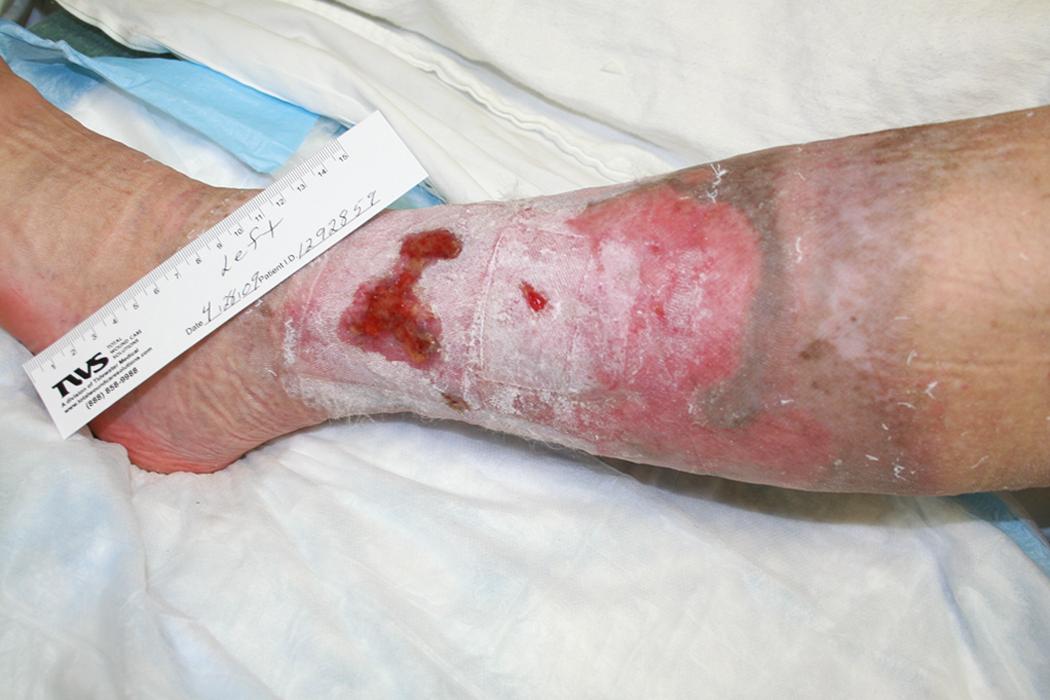
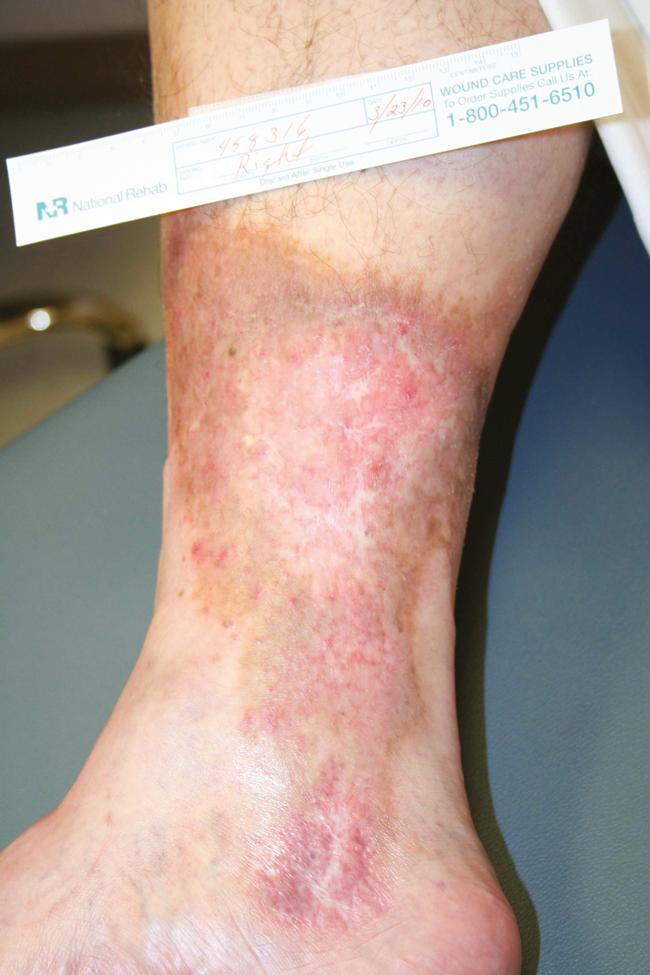
For most patients, well-applied, sustained compression therapy offers the most cost-effective and efficacious therapy in the healing of venous ulcers. After healing, most cases of CVI are controlled with elastic compression stockings to be worn during waking hours. On occasion, older patients and those with arthritic conditions cannot apply the compression stocking required, and control must be maintained by triple-layer zinc oxide compression dressings, which can usually be left in place and changed once a week. In addition to compression, wound care, and surgery, large chronic venous ulcers may benefit from venoactive medications, in particular, pentoxifylline and micronized purified flavonoid fraction.
Indications for interventional treatment are symptoms refractory to conservative therapy, recurrent superficial thrombophlebitis, variceal bleeding, and venous stasis ulceration. After clinical and objective criteria have established the presence of symptomatic varicose veins, the next step is to plan a course of therapy. The Eschar Trial randomized 500 patients with saphenous insufficiency and venous leg ulcers to conservative management with compression therapy to saphenous stripping and compression therapy. At 4 years of follow-up, there was no evidence of a significant difference in ulcer healing rates but the incidence of ulcer recurrence after healing was significantly lower in patients who underwent saphenous stripping. ,
The efficacy of conservative versus surgical treatment for varicose veins was studied in the Randomised Clinical Trial, Observational Study and Assessment of Cost-Effectiveness of the Treatment of Varicose veins (REACTIV) trial. The authors concluded that surgical treatment was more cost-effective and patients had a higher quality of life benefit than the group who had maintained conservative management alone with compression therapy. ,
By definition, telangiectasias, as they are structures with diameters smaller than 3 mm, are not appropriate for surgical treatment. Asymptomatic telangiectasias are of cosmetic concern only. In these asymptomatic patients with only C 1 disease, a reflux examination is not indicated. However, if the patient describes symptoms consistent with possible venous insufficiency or has concomitant varicosities or more advanced disease on physical examination, a reflux examination is indicated. Treatment options for telangiectasias (spider veins and reticular veins) include injection sclerotherapy and transdermal laser treatment ( Fig. 65.9 ).
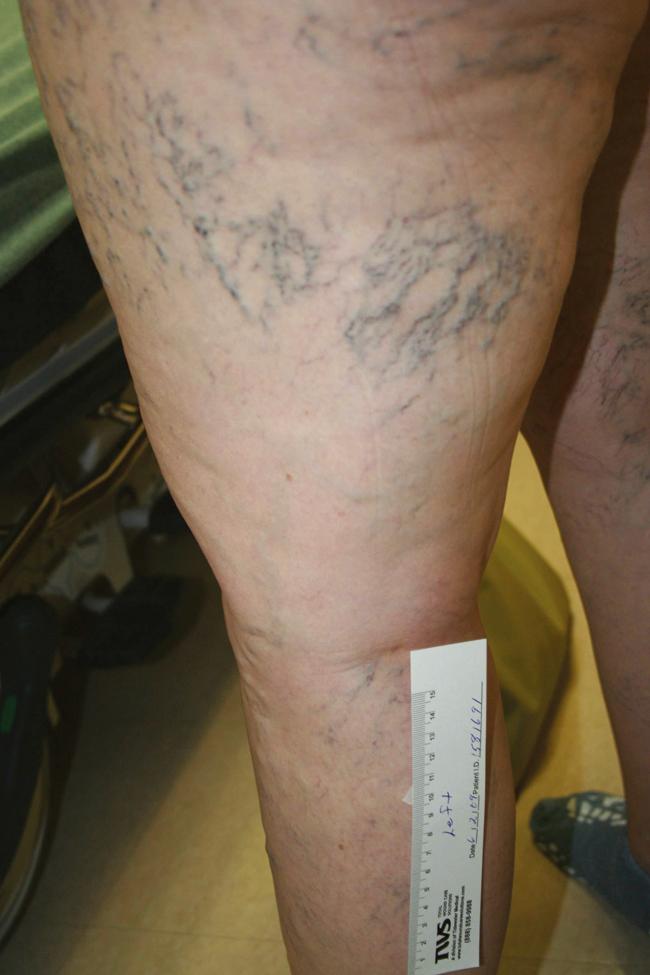
Injection sclerotherapy is a technique that involves direct injection of a sclerosant agent into the feeding vein (reticular vein) or spider vein. This procedure is performed in the office setting. There is no preprocedural preparation of the patient. However, patients are asked not to shave or to apply lotions to the extremity before the treatment. Patients leave the office and are able to perform regular activities immediately. Direct sunlight exposure to the treatment area is avoided for a few weeks after the injection. Although it is a safe technique, injection sclerotherapy is contraindicated in the following situations: pregnancy, patients receiving anticoagulation, patients with acute superficial thrombophlebitis, patients with acute DVT, and patients with a history of severe allergy or severe asthma.
Sclerosants act to disrupt the venous endothelium, causing a periphlebitic reaction, which acts to obliterate the vein segment. There are many sclerosants available, and there are particular categories of sclerosants. They include osmotic, detergent, chemical, and corrosive. Hypertonic saline, in various concentrations, was long considered the agent of choice; however, it can be painful with injection (despite the addition of lidocaine) and appears to exhibit a higher incidence of hyperpigmentation after treatment. Therefore, varying concentrations of sodium tetradecyl sulfate (Sotradecol) and polidocanol (Aethoxysklerol) are now the preferred agents.
The procedure should be performed in a well-lit room. Dilute solutions of sclerosant (e.g., 1% to 3% sodium tetradecyl sulfate; polidocanol 0.5%, 1%, 1.5%) can be injected directly into the venules. Care must be taken to ensure that no single injection dose exceeds 0.1 mL but that multiple injections completely fill all feeding vessels. Larger spider veins should be injected first. Injection should begin proximally and proceed distally. When the session is complete, a pressure dressing is applied, consisting of cotton balls at each injection site, and then covered with compression stockings. Patients are advised to ambulate frequently during the first 24 hours and to abstain from direct sun exposure and airline travel for 2 weeks. On occasion, entrapped blood may form, and patients report significant discomfort. Needle drainage is performed at the site, which facilitates healing and cosmesis and rapidly improves discomfort. This liberation of entrapped blood is as important to success as the primary injection. This therapy is remarkably successful in achieving an excellent cosmetic result. C 1 larger than l mm and smaller than 3 mm can also be injected with a sclerosant of slightly greater concentration, but the amount injected at one site needs to be limited to less than 0.5 mL. A total volume of sclerosant should not exceed 4 mL during a treatment session. If one is using hypertonic saline, maximum treatment volume can be 10 mL. Although injection sclerotherapy has met with significant success, complications do occur. They include hyperpigmentation, venous matting, postsclerotherapy necrosis, and an allergic reaction to the sclerosant. In addition, telangiectasia formation after injection sclerotherapy treatment tends to occur. Patients will commonly observe return of spider veins 8 to 12 months after treatment. Although patients may report localized discomfort, sclerotherapy of telangiectasias is considered cosmetic and does not influence the venous circulation of the extremity.
Laser treatment of spider telangiectasias has been performed with a variety of wavelengths and varying techniques, such as high-intensity pulsed light, fiber-guided laser coagulation, and neodymium:yttrium-aluminium-garnet laser with a wavelength of 1064 nm. Evaluation of all existing laser modalities has suggested that the neodymium:yttrium-aluminium-garnet laser has the most success. However, to date, there have not been any prospective randomized trials to support this presumption. Laser treatment does tend to be more painful. Laser treatment in most centers will be used in conjunction with injection sclerotherapy, that is, injection treats the feeding venules; laser treatment will be used to treat the extremely small branches not adequately addressed with the injection technique. Most patients are satisfied with the injection-only method.
Become a Clinical Tree membership for Full access and enjoy Unlimited articles
If you are a member. Log in here